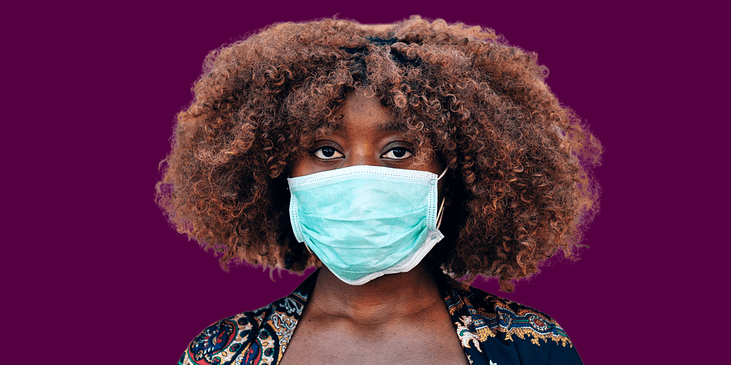by Hailey Hudson
As the vaccine rollout continues across the globe, our social media feeds are full of photos from cookouts, videos from vacations and status updates of being back in the office once again. Most people feel nothing but joy about getting back to “normal.”
But the disability community, however, isn’t necessarily joining in the celebration.
While the COVID-19 pandemic has been a terrifying and difficult time for all, many disabled people have found a silver lining. As the world became virtual, it became easier to participate in many activities and events that were previously inaccessible. Doors that had been previously closed were now swinging wide open. And as the world returns to “normal,” this newfound access is something many people with disabilities don’t want to lose.
Here’s how COVID-19 helped make the world more accessible and why it’s such a big deal that these accommodations are now being taken away.
How COVID-19 Made the World Accessible
Over one billion people globally live with disabilities, and that number is only going up. In the U.S., employers are required by law to offer “reasonable accommodations” to disabled employees. Most other countries have some type of equality legislation that applies to people with disabilities such as India’s Persons with Disabilities Act, Vietnam’s Law on Persons with Disabilities, the United Kingdom’s Equality Act and many others. But making these accommodations available is more often said than done.
That’s why for somebody who is disabled, an option for remote work is often key. Many disabled people may be unable to work full-time in an office or other environment. Working from home, however, allows an employee to create a setup that’s fully accessible to them. And while many employers were uncomfortable with remote work before COVID or flat-out refused to let disabled employees work from home, those same companies sent all of their employees home when the pandemic hit.
It’s not just the workplace that became more accessible during COVID. As events, social activities, doctor appointments and virtually every facet of our lives moved online, many disabled people found they were able to participate in the world in a way they had never been able to before. They could speak at or attend conferences without having to worry about the travel. They could join in birthday parties or holiday celebrations from the comfort of their own accessible home. And when they did need to venture out into public spaces, social distancing and contactless options benefited many people with disabilities.
It’s no wonder then, why the disabled community is reluctant to return to the life we all once knew.
Returning to “Normal” Post-COVID
The COVID-19 pandemic increased accessibility for the disability community. But will these options continue to be available long-term? The jury is still out.
According to the consulting firm McKinsey, companies saw a surge in productivity when their employees switched to remote work during the pandemic.
Ninety-four percent of employers surveyed by Mercer, an HR firm, also said that productivity at their company was either the same as or higher than it was before the pandemic, SHRM reported.
Hoping to capitalize on that increase in productivity, some organizations are now planning to offer a combination of in-office and work-from-home options.
But many employees don’t feel reassured. While companies are talking a big game, many of them have yet to roll out detailed guidelines on what these remote work opportunities are going to look like. And for some disabled employees, that leaves them wondering whether the idea of remote work post-COVID is too good to be true.
According to The New York Times, in the U.S., just 48 percent of the country is fully vaccinated. In countries like Congo, Papua New Guinea, Jamaica and Nepal, less than five percent of the population has been fully vaccinated.
And as mask mandates are now being lifted, more and more people are also ditching their masks in public. In some countries outside the U.S., wearing a mask during flu season was the norm even pre-pandemic. Continuing to wear masks would help protect disabled people who have weakened or compromised immune systems and are vulnerable to all sorts of viruses and illnesses beyond just COVID. But with so many people tossing their masks, it’s no wonder why disabled people are worried about returning to what used to be the norm.
Lifted mask mandates put the disability community at risk immediately as well as long-term. Although many people are excited and ready to return to normal, the pandemic isn’t over yet. New and highly contagious Delta variants are spreading quickly among unvaccinated populations. Rushing to get back to normal overlooks people who have not been able to get vaccinated yet and puts their lives at risk as well as those with compromised immune systems.
Including the Disability Community Long-Term
The disability community has been pushing for accommodations — such as remote work options and telehealth appointments — for years. But for years, the disability community was denied — until COVID-19 rolled around and suddenly everyone was receiving the accessibility accommodations disabled people had needed long before.
As many people push to return to “normal” life, it’s growing increasingly clear that our idea of “normal” really just applies to a world full of non-disabled people. And that’s not OK.
Organizations need to stop and think about how COVID protocols may have actually improved life for disabled people. “Returning to normal” and denying these accommodations makes people with disabilities feel overlooked, left out and unwanted.
During the COVID-19 pandemic, many disabled people experienced being able to fully participate in social activities, advance their careers and stay safe as they navigated the world. But after getting a taste of what life could be like, they’re being left behind once again. This is prime time for our world to make a change and show the disabled community they’re valued enough to make these adjustments. By continuing to provide accessible technology and other accommodations, we can create a more accessible world for everyone.
Related Links: Learn more about WID’s Emergencies, Disasters, and Climate Resilience Program

Hailey Hudson is a Freelance Writer for WID.


0 comments on “Why People With Disabilities Don’t Want to Go “Back To Normal””